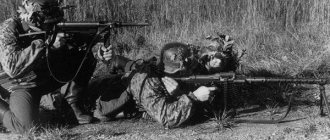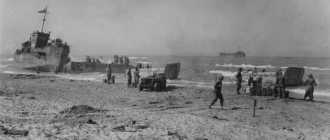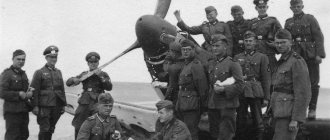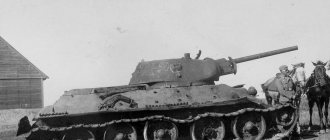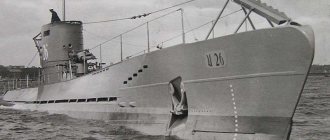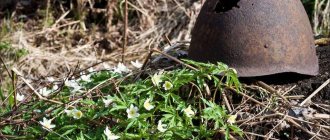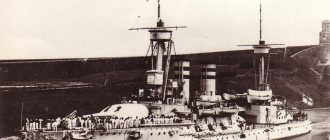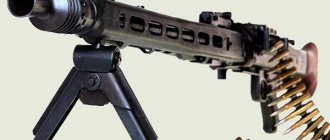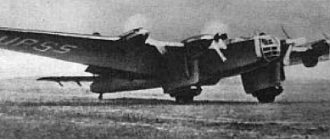ShKAS
Soviet rapid-fire 7.62 mm aircraft machine gunIn 1920, while working as a mechanic at one of the factories, Boris Gavrilovich Shpitalny set out to make a high-speed machine gun. But at that time he did not have the necessary experience and lacked knowledge. After graduating from the institute, the young engineer began to implement his plan and soon presented a project for such a machine gun, which attracted attention with its exceptional courage in solving a number of complex issues in the design of automatic weapons. an experienced weapons designer Irinarkh Andreevich Komaritsky 1930 was seconded to him to assist Shpitalny The first sample of a high-speed aircraft machine gun was manufactured, created by Shpitalny with the participation of Komaritsky. This was the world's first aviation system, which immediately put the USSR in first place in this area of weapons. The automatic machine gun worked by removing powder gases, power was supplied from a loose metal link belt. The design consisted of a barrel with a casing, a receiver with a cover, a bolt frame with a rod and piston, a bolt, gears, a gear casing, a feed lever and its cover, a coupling with a loading handle, a reflector, a sleeve catcher, a trigger mechanism, a butt plate. The barrel was attached to the casing with a cracker connection. The barrel chamber is of a floating type, that is, with longitudinal grooves on the walls extending beyond the front cut of the sleeve (Revelli grooves). After the shot, part of the powder gases rushed into the grooves, reducing the pressure difference on the walls of the cartridge case and the force of its adhesion to the walls of the chamber. This facilitated extraction and prevented case rupture at high bolt speeds. A transverse gas outlet hole was made in the barrel wall 180 mm from the muzzle. A closed-type gas chamber was located above the barrel and was equipped with a plug - a gas regulator with three holes with diameters of 2.5, 3.0 and 3.5 mm. The casing with the barrel was attached to the receiver with a coupling. The barrel was cooled by air, although in 1939 a water-cooled version was also tested. The leading link of the automation was the bolt frame, rigidly connected to the piston rod. A three-core return spring was placed in the rod channel. The barrel bore was locked by skewing the bolt downwards, while the rear beveled section of the bolt stood on the combat stop of the receiver behind the receiving window. Locking and unlocking of the bolt was carried out by a figured vertical protrusion of the bolt frame. The total mass of the moving system was 921 g, the reverse speed was from 9.0 (with a 2.5 mm gas outlet) to 12.1 m/s (with a 3.5 mm hole). The firing pin was mounted in the bolt. The shot was fired from the rear sear, which is natural for a machine gun with a high barrel heating. The combat platoon was located on the left side of the bolt frame. The trigger mechanism was assembled in a separate housing; to increase survivability, a sear buffer spring was introduced into it. When the bolt frame came to its extreme forward position (that is, after the bolt was locked), its protrusion hit the firing pin
The main highlight of the ShKAS was the power supply system, which, in fact, made it possible to achieve such a high rate of fire - 1800 rounds per minute. The cartridge was fed by a gear (drum) with 10 slots, rotating on a longitudinal axis inside a stationary casing. A screw groove was made on the gear axis and the inner surface of the casing. When the piston rod moved backward, its curved ridge pressed on the drive roller of the feed lever, which swung in a horizontal plane, and turned it to the left. The lever turned the gear with its finger. The cartridge, picked up by the gear, entered the rim of the sleeve into the screw groove. In one automation cycle, the gear rotated 1/10 of a turn, while the cartridge slid along the screw groove, was removed from the loose belt link and moved back. Thus, the removal of the cartridge from the belt and its feeding occurred smoothly - the cartridge approached the receiving window of the receiver in a full turn, i.e. 10 shots. Here it was picked up by a lever feeder and pressed against the receiving window, holding it raised upward. This made it possible to reduce the length of the shutter stroke. Continuous operation of the feed mechanism, reducing the speed of movement of the belt and cartridge when feeding it to the dispensing line prevented their damage, destruction or distortion (however, the strength of the cartridge case and the bullet fastening in it for aviation cartridges still had to be increased). In addition, the described system made it possible to reduce the length of the weapon, which is important for placement on an airplane. When loading the machine gun, it was necessary to release the gear, bring the cartridge belt to it and, using the folding loading handle, turn the gear, inserting 8-9 rounds into it, then turn on the feeder. The ejection mechanism was no less ingeniously designed. His work was divided into two stages. When moving backward, the bolt frame rotated the reflector in the transverse plane. He pushed the cartridge case out of the bolt legs into the side socket of the receiver, where it was held by a spring-loaded cartridge case catcher. From here it was pushed out through the sleeve hole by the protrusion of the rod when moving forward. Spring buffers of the bolt frame and bolt were mounted in the butt plate. They not only softened the impact of the moving system in the rear position, but also increased the initial speed of its return forward. In combination with the short shutter stroke and the timing of reloading operations, this reduced the duration of the automation cycle and increased the rate of fire
ShKAS was a first in many respects. The PV-1 of Nadashkevich, DA and DA-2 of Degtyarev that preceded it were a continuation of the experience of the First World War - infantry machine guns Maxim and DP-27 . ShKAS became the first specially aircraft machine gun, designed taking into account the requirements of its time. Continuous feed of the tape, multi-core return spring - this was implemented in ShKAS for the first time. It is also the first time that such a rate of fire has been achieved in single-barrel systems. In fact: the 7.62-mm French belt-fed Darn aviation machine gun gave 1100-1200 rounds per minute, the English 7.7-mm Vickers-R (magazine-fed) - 1000, the American 7.62-mm Colt-Browning (tape) - 900, German 7.92-mm MG-17 (tape) - 1100 ShKAS was used in three versions. The I-16 fighter was the first to receive this weapon - in the form of wing-mounted machine guns without sighting devices, with a cable reloading mechanism and a system of cables for release. In the turret version, a weather vane (or front sight) stand was attached to the muzzle of the barrel, and a ring sight stand was attached to the casing (rear sight), on the butt plate there is a holding handle. There was a control handle with a trigger connected to the sear through a transmission lever. The safety lever locked the sear. The reloading handle served to move the moving system to the rearmost position and remained motionless during firing. The barrel casing has changed. The turret installation was developed by N.F. Tokarev. For example, the TB-3-AM-34RN bomber had four Tur-8 installations. Later, with the creation of new aircraft, other versions of turret (blister) installations were developed. Finally, in 1936, a synchronous version was adopted ( ShKAS model 1936), developed by K.N. Rudnev, V.P. Kotov, V. N. Salishchev. The synchronizer, allowing firing through the propeller, reduced its rate to 1650 rounds/min, but some lengthening of the bullet acceleration path increased the initial speed to 800-850 m/s Development by N.M. Elizarov of variants of a rifle cartridge with armor-piercing incendiary, tracer, incendiary bullet completed the formation of an aviation machine gun complex. The production ShKAS guns was continuously increasing: if in 1933 365 pieces were assembled in a semi-handicraft way, and in 1934 - 2476, then in 1937 - 13,005, in 1940 - 34,233. True, there was greater interest in the beginning of the war called for aircraft weapons of larger calibers - in 1941 they planned to produce only 3,500 ShKAS and 30,000 spare barrels for them. Let's list the types of aircraft on which the ShKAS : I-16 , I-153 , Yak-1 , Yak-7 , LaGG-3 , MiG-3 Il-2 attack aircraft, TB-3 , TB-7 , Su-2 , He-2 , Tu-2 , Il-4 , Er-2, U-2 (Po-2) , reconnaissance aircraft R5-SSS , PZ, Be-2 (ship), military versions of Li-2 . ShKAS installed instead DShK on torpedo boats G-5 and D-3. In 1939, the ultra-high-speed Ultra- ShKASS - the automation cycle time in it was reduced, giving the barrel a forward movement after unlocking. The SB was equipped with bow installations with twin ShKAS . In 1935 - 1937 K.N.Rudnev, V.N.Polyubin, A.A.Tropenkov worked on the so-called mechanical twin ShKAS (MSSh) - organically coupled ShKAS with a rate of fire of up to 6000-6400 rounds per minute. The machine gun rods were equipped with gear racks and connected by a gear - the automation cycle included two shot cycles, and the maximum recoil force did not exceed its value with one shot. But it is significant that further work in this direction was interrupted due to the planned transition to large-caliber machine guns. For the first time, ShKASs on Soviet fighters were used in air battles in November 1936 over Madrid (at the same time, bombers also fought in the skies of Spain, also carrying ShKASs ). , I-15 and I-16 armed with them fought with Japanese aircraft over China. ShKAS proved themselves both in the battles at Khalkhin Gol and in the Soviet-Finnish war. ShKAS also used the Great Patriotic War . It was from ShKAS the most effective air gunner Andrei Pihota shot down six aircraft in one battle. However, by the early 40s, the increase in passive protection of aircraft (reservation of crew workplaces, protection of gas tanks) led to the fact that the effectiveness of rifle-caliber machine guns, including ShKAS , in the fight against enemy aircraft, sharply decreased; they could destroy an enemy aircraft only with a very large number of hits.
Annexation of Crimea to RussiaRus and the Kaganate Reunification of Ukraine with Russia Annexation of Kazakhstan to Russia Capture of Tashkent Battle of the Ice Battle of Kulikovo Defeat of the Khazar Kaganate Battle of the Neva Standing on the Ugra River
Review of the Berezin universal machine gun (UBT-turret modification)
12.7x108 mm
from the @xo.expert collection
On April 13, 1939, by decree of the USSR Defense Committee, the BS synchronous machine gun designed by M.E. Berezin was adopted into service by the Red Army, which rightfully earned the title of best in its class.
A machine gun from a Soviet IL-2 attack aircraft, shot down in an air battle in the summer of 1944 on the Karelian Isthmus, when, upon returning to the airfield after an attack, a “two” Bf-109 entered a frontal attack on the wounded plane... Air gunner's combat position. Crew: pilot-navigator of 566 ShAP, Major Timofey Konstantinovich Zelenko, died along with the vehicle. Gunner-sergeant Alexander Ivanovich Anashkin, before the war, a simple school teacher. Left the plane with a parachute. It was he who sat behind that machine gun that day. At the front since July 1941. Made more than 100 combat missions (which is incredible for an IL-2 gunner!). He was shot down three times and burned. He was captured and escaped. Personally shot down a German FW-190 fighter in battle. He was rightfully considered the BEST shooter of the regiment. I went through the whole war and met victory in Koenigsberg. - information from the blog @xo.expert
It is curious that at the time of the appearance of the first prototypes of the machine gun, the name of the designer at that time was not known even in the Armament Directorate of the Main Directorate of the Air Force, so in some documents the name of the machine gun was written as follows - 12.7-mm machine gun "Berezina", believing that it was chosen by name rivers.
Photo of the machine gun after rising from the swamp.
popular gas outlet scheme
In the project, Berezin chose a gas-operated automation scheme that was quite popular in those years, which had a number of advantages over other schemes, in particular, compact design, reliable operation, less dependence on the dispersion of cartridge power, and since the barrel remains stationary when fired, greater accuracy of fire.
| Caliber, mm Type of automation Machine gun weight, kg Gun length, mm Barrel length, mm Barrel weight, kg Rate of fire, rds/min Initial projectile speed, m/sec Type of cartridge Magazine capacity Bullet weight, g Weight of armor-piercing incendiary cartridge, g. Weight of powder charge, g. | 12.7 gas outlet 24.2 (BS) 21.45 (UBS); 21.14 (UBK); 21.43 (UBT) 1347 (UBS, UBC); 1397 (UBT) 890 6.135 800-1050 (700-800 in the UBS version) 840-860 12.7x108 mm tape 38.25 ≈ 55.5 130 17 - 18 |
In October-December 1938, the BS (Berezina-Synchronny) machine gun passed a series of factory and field tests, showing exceptionally high performance, good survivability and reliability of its automation. Thus, with a mass of just over 24 kg, the machine gun had a rate of fire of up to 1000 rounds/min, when working with a synchronizer, which inevitably dropped to 700-800 rounds/min, which still exceeded those of any contemporary foreign model. And the use of an exceptionally powerful cartridge made the final salvo of this weapon the most powerful in the world, comparable to 20 mm systems of that time.
bottom view of the feeder
On April 13, 1939, even before the completion of military tests of the machine gun, on the basis of a resolution of the Defense Committee, the machine gun was put into mass production.
Design and purpose of individual mechanisms and parts of a machine gun
The machine gun consists of the following main parts: an assembled barrel, an assembled receiver, moving parts, a power mechanism (receiver), a firing mechanism, a trigger mechanism, a receiver cover, a comb, a butt plate for the pneumatic reloading cylinder and individual parts.
The assembled barrel consists of the following parts: the barrel itself, the gas cylinder, the front clutch, the rear clutch, the front clutch pin, the gas cylinder pin, the rear clutch pins, the gas regulator, the gas regulator pin and the cotter pin. The trunk is a pipe. There is a chamber in the breech of the barrel; The bore has 8 rifling, running from left to right. The groove pitch is 381 mm, the groove depth is 0.17 mm, the width of each groove is 2.8 mm. Rifling angle 6 degrees 2 min. 27 sec.
The gas regulator serves to regulate the rate of fire of the machine gun.
The gas regulator pin serves to mount the gas regulator and the gas cylinder in the front clutch.
The cotter pin prevents the pin from falling out of the gas cylinder.
Machine gun design
Mikhail Evgenievich Berezin began designing a powerful 12.7-mm synchronous aircraft machine gun back in 1937. It is characteristic that there were no instructions “from above” to create weapons within the framework of any state program. Apparently the work on designing an aircraft machine gun was initiated inside the plant. The machine gun was originally created for the powerful 12.7x108 mm cartridge from the DShK infantry machine gun.
The first pneumatic reloading system in Soviet aviation
This was the first Soviet aviation machine gun to feature a pneumatic reloading system, which significantly made life easier for the pilot and the operation of the machine gun in combat conditions. Moreover, due to the impossibility of using this system on the turret version of the machine gun (the reason was the dimensions of the cabin), designer G. I. Nikitin designed a new lever-type reloading handle for the UBT, located on top of the receiver in the horizontal plane.
Military trials
Military tests of the new version of machine guns took place in 1941, they took place from January 7 to February 22. Synchronized machine guns were tested in the 116th Aviation Fighter Regiment on I-153 and I-16 aircraft. A total of 6 machine guns were tested, from which a total of 48,286 rounds were fired, including 36,870 rounds in the air and another 11,416 rounds in a ground shooting range. In the air, firing from a 12.7-mm machine gun was carried out at altitudes from 1 to 9 thousand meters in bursts of 20-50 shots. Testing the operation of the automatic machine gun in conditions of low air temperatures was carried out by shooting at an altitude of about 8-9 thousand meters, where the air temperature reached -42 -48 degrees Celsius.
The effect of inertial forces on the operation of the Berezin machine gun was tested by freely firing a cartridge during various aerobatics: on combat turns, deep turns, rolls, loops and during a dive. In all cases, the machine guns installed on the fighters worked reliably, giving a small number of delays. Moreover, when firing, the machine guns, without additional lubrication and cleaning, could fire an average of 1,470 rounds of ammunition, which made it possible to carry out up to 5-6 combat missions per day without removing the machine gun for maintenance.
Berezina universal machine gun (UBT-turret modification)
After the successful completion of the main air test program, the machine guns were subjected to survivability tests in a ground shooting range. The average survivability of a machine gun barrel was 10-12 thousand rounds. At the same time, the new machine gun was highly praised by test pilots who shot it in the air. Senior Lieutenant Kryuchkov reported that during military testing, the BS machine gun demonstrated itself to be quite suitable for adoption by the Red Army Air Force. During testing, the machine gun demonstrated uninterrupted operation, with only a few easily removable delays in firing. Therefore, Kryuchkov considered the machine gun’s performance excellent, and other pilots who participated in its tests shared the same opinion. The commission, headed by Hero of the Soviet Union Colonel N.P. Kamanin, noted in its conclusion that the 12.7-mm synchronous machine gun designed by Berezin had passed the tests and could be put into service.
Mikhail Evgenievich Berezin
Mikhail Evgenievich Berezin began his career at the age of nine, working as a farm laborer, laborer, lumberjack, and carpenter. In 1926 he entered the workers' faculty at the Leningrad Polytechnic Institute, then the Leningrad Military Mechanical Institute, after graduating in 1934 he worked at the Tula Arms Plant as a shift foreman, then as a design engineer.
Mikhail Evgenievich Berezin
In 1935, he moved to the design bureau, where he developed a 12.7-mm heavy machine gun, which became the first independent work of the young designer.
Ammunition 12.7 mm, found during recovery of part of an IL-2 aircraft
